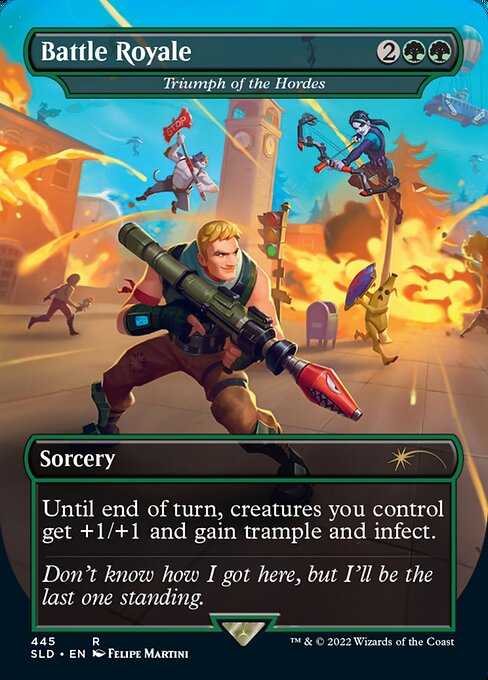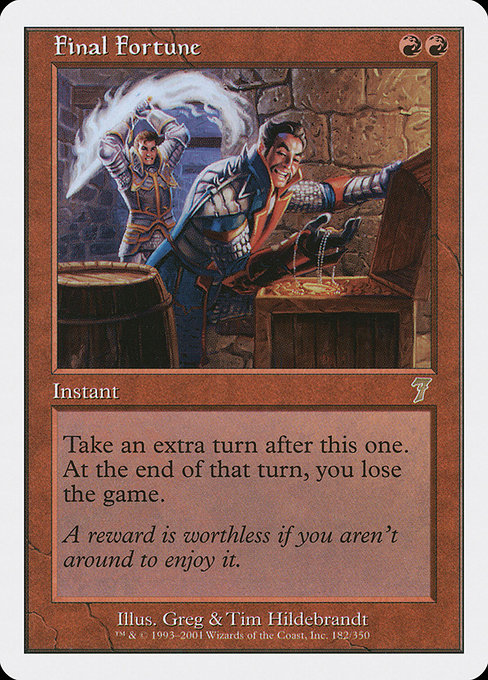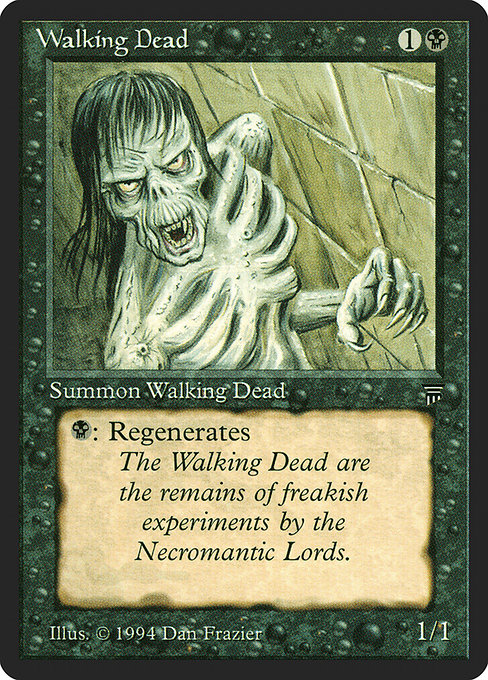Magic can be tailored to be anything: some purists only play Old School or Premodern or Pre-Dh or Urza Block Constructed. Some Commander playgroups have a house banned list longer than the United States Constitution and only slightly less antiquated. Alternately, if you embrace the full scope of Magic, you can play a Commander pod where Gandalf and Bumblebee team up with the cast of Stranger Things to defeat Bio-Quartz Spacegodzilla.

I haven’t come around on Universes Beyond, but I’m less snide about the subsets than I was–I may not enjoy seeing Starscream or Battle Royale on the Commander table, but the more Magic-adjacent side of Universes Beyond has given me Orcish Bowmasters and The Three Weird Sisters. More importantly, with the recent news that Tales of Middle-Earth is projected to be the best-selling Magic set of all time, Universes Beyond is clearly not going anywhere.
We can see from past Universes Beyond what to expect in future sets–previous editions have either been a) a slightly outdated monocultural IP or b) a long-lasting niche property with audience overlap. Because it takes time to lock down a license and develop and print cards, the pop culture Universes Beyond sets have lagged behind their period of peak popularity. The Walking Dead Secret Lair dropped in October 2020, at a time when the show’s ratings were plummeting. The deal was presumably inked sometime during the massive ratings boom of seasons six and seven, but by the time the cards dropped, the show was playing to a fraction of its former audience.
By contrast, the Fortnite agreement must have been signed a while before the July 2022 debut of its Secret Lair and after the game’s 2017 launch; in 2023, the game is still going strong–estimates vary, but monthly players are calculated in the millions. It could have easily been a flash in the pan, and in the period between initial licensing discussions and eventual product rollout, Wizards could have looked like it was chasing outdated trends. The other way to ensure relevance is to go for an established property, like Lord of the Rings or Dr. Who, the Universes Beyond set for which will release just before the 60th anniversary of the show’s premiere.

Dr. Who has a fanatical fanbase that kept the show relevant during the fifteen years when it wasn’t airing episodes; while the show is projected to return next year, it’s been over two years since the last episode aired (presumably around the time Hasbro and the BBC signed a deal, but that’s purely speculative). These things take time, from design and development to prototyping and production, and the COVID pandemic and attendant labor and supply adjustments have altered timelines. In addition, any big swing is risky–licenses can be costly and siphon away profits from a crossover, independent intellectual properties can be diluted when commingled or can appear desperate, and sometimes, the vibes of two voices in one project simply don’t mesh (c.f. Metallica and Lou Reed in Lulu).
There are two ways to play it safe when you’re developing Universes Beyond. There are internal crossovers–that is, cultural properties that Hasbro owns like My Little Pony and Transformers and (to an extent) The Walking Dead. You can reduce risk by keeping it in-house–all promotion can be controlled by your team, and you can self-police. These acts of corporate synergy are different from the external crossovers we see in sets like Warhammer 40,000 and Tales of Middle-Earth, which are licensed from other corporations. We don’t have access to Hasbro’s market research, but we can speculate on its outcomes based on where Wizards pivots to–some of which is very unsurprising (Magic visiting Middle-Earth is the equivalent of you attending your grandfather’s 80th birthday party) and some of which is less expected, like next year’s Final Fantasy cards. The goal there, as it has successfully been proven with Tales of Middle-Earth, is to draw a new audience to Magic by fusing its game system with an established world; this is all basic stuff, but it’s worth emphasizing: the point of Universes Beyond is to sell more cards to new audiences.

Per the most recent Axios Harris Poll, which surveyed 16,000 people in the U.S., the most popular brands in America are Patagonia (outlier, as its primacy is presumably affected by recent positive press coverage), Costco, John Deere, Trader Joe’s, Chick-fil-A, Toyota, and Samsung. That’s not useful to our discussion, as I doubt we’re going to see Food tokens with a Costco chicken bake or a Legendary Vehicle that’s a RAV4, so we’ll have to delve into the media companies, of which the only three that make the Axios Harris cut are Netflix, the Walt Disney Corporation, and the Fox Corporation. I don’t expect a Disney crossover with the ongoing launch of Lorcana and the inbound collapse of Marvel, and the Fox Corporation is the sports and propaganda outlet spun out of the Disney/21st Century Fox merger in 2019, so it’ll hopefully never be relevant to Universes Beyond. This leaves us with Netflix, with whom Wizards has already created Secret Lairs for Stranger Things and Arcane. I doubt we’ll see Cunk on Dominaria or I Think You Should Planeswalk any time soon, but there are a few Netflix properties that seem able to be spun out in Universes Beyond cards.
Netflix’s Sweet Tooth is a pretty anodyne adaptation of Jeff Lemire’s thorny and chilly graphic novels, but it’s well-reviewed and its third season is currently in production. Lemire isn’t a household name just yet, but he’s a draw at comics conventions and has an immediately recognizable style. A Lemire-illustrated set of Snow-Covered lands would be an easy fit, or closeups of Legendary Creatures in his blocky, weathered closeups would be a great evolution of Commander Masters’ pop art portraits.
The David Production adaptation of JoJo’s Bizarre Adventure began airing in America in 2016, but the launch of the fifth season on Netflix at the end of 2021 brought it to a new audience. An easy layup here–JoJo is full of flashy style and slashy combat and has a devoted fanbase. There’s potential here for a Street Fighter-style Secret Lair, with over-the-top Stands and the manga’s characteristic references to American pop culture and rock music (which may involve a secondary level of licensing). Seems more like an “when” than “if,” to use Mark Rosewater’s preferred terminology.
Aside from Netflix, Hades 2 is an easy pick for Universes Beyond. Supergiant’s divine roguelike is stylish and solidly PG-13, with the rating due to neon-colored mayhem and egalitarian sexualization of its characters. It has a devoted following that’s given to fanart and cosplay (which, to cynics, is better known as “uncompensated marketing”). The game is projected to launch on PC in “early 2024,” which, knowing the games industry, could be adjusted to a later launch, but if the timeline can be nailed down, a tie-in Secret Lair with Hades reskins of Theros gods would get a few thousand obol.

That’s part of the difficulty of landing on IP ready for UB adaptation: Magic is restricted in what it can do by content–as a strictly PG-13 game, it’s going to stay mostly with similar brands like Street Fighter and Stranger Things, rather than Mortal Kombat and Midnight Mass. There was a bit of pushback to a Magic representation of The Walking Dead’s Negan, for example, and, when you work with artists, you always run the risk of real-world politics or misbehavior ruining your brand. This means that some easy pitches for Universes Beyond aren’t feasible: Berserk, for example, has significant crossover appeal to Magic players–Miura’s recent death, the popularity of Berserk-inspired From Software games, and the ongoing release of massive omnibus editions of the manga have all contributed to a surge in awareness of the manga, but its content is a bit extreme for Hasbro. Crossovers are designed to bolster the popularity of both properties, and Hakusensha/Dark Horse may not be excited about a cross-promotion where one side does the heavy lifting.
With Universes Beyond, Wizards seems to be branching out to a truly casual consumption model. Rather than sell booster boxes to Magic players, they’d rather sell booster packs to an audience of multiple millions. It makes sense–which is more sustainable: selling one Magic player $5,000 worth of boosters over a period of years or selling 1,000 Magic neophytes $5 worth of boosters in one week? Those 1,000 players may never purchase another booster, may never even play a game of Magic, but you got their money and the majority of them never feel the pinch. The slow drip of the single player may dry up at any time–an enfranchised player who pays attention to spoilers and metagame developments may take a year or two off.
The herd is fickle, but there’s always more of them. To be less cynical, what Wizards is attempting to do could create new Magic players–I don’t believe the millions of packs of Tales of Middle-Earth all went to Ring-hunters and fastidious collectors, but to people who have been curious about Magic: the Gathering for years and just needed that extra push to buy in. It’s a brilliant way to deepen your audience–people who are conversant with Warhammer or Lord of the Rings don’t have even a hint of the lingering stigma of “that stuff’s for dorks/Satanists” that characterized Magic’s initial popularity, and they are already proven to have disposable income.

We don’t know how many of the thousands of Walking Dead Secret Lairs were opened or how many sit on a curio shelf with Darryl Dixon Funko Pops and Star Wars Black Series action figures mint-in-box. We just know it was (at the time) Wizards’ best-selling Secret Lair drop, but can’t speculate on how many new players–if any–it created or how many kept playing the game through today. To Wizards, it doesn’t matter: while Magic has a tournament scene and a legacy that tracks back decades, the cold fact is that, for Hasbro/Wizards, the only metric of success is “did the cards sell and did they sell more this quarter than last?” Certainly, the game’s health matters, but only in the same way that you care about the health of the goose that lays golden eggs.
Magic, as a product, inspires fanatical consumption. It’s an excellent game system that is sold in psychologically predatory ways–randomized booster packs, time-limited Secret Lairs, digital microtransactions. These players may cavil about reprint equity and power creep and format rotation, but they–okay, I’ll admit it, we–are still lining up to buy boosters by the box, and Wizards has a hard time alienating us. They may botch a product, as they did with Aftermath and appear to be doing with Commander Masters, but we’re hooked. I can sneer at Fortnite cards and ignore $100 Commander precons, but you give me the chance to draft Necropotence again, and I’m preordering Wilds of Eldraine sight unseen.

Magic’s story, though, has always been secondary to its gameplay, a problem that remains unsolved after twenty-five years. It’s difficult to convey a full story through cards that players will see randomly, with art that measures a couple of square inches, with characters that are more archetypes than motivated, memorable individuals. The Weatherlight Saga was not an unqualified success, the online story era has been lost to media fragmentation and server migrations, and officially branded texts don’t sell well enough to justify the cost. With the 2021 announcement of Universes Beyond, we see Wizards hint at the real solution: blend Magic’s top-of-the-industry “game system” with the characters artists have established.
Few players cared what Gerrard Capashen did or how his (underpowered) abilities tied into his four-year character arc; those same players, however, would speculate on forums about what a hypothetical Spider-Man card would look like. The recent popularity of Mattel’s Greta Gerwig-directed Barbie and its four-quadrant appeal to the major demographics has to have sunk in with Hasbro higher-ups–the Mattel film push is now beginning with upcoming adaptations of Polly Pocket and Barney from the youngish cohort of capitalism-sympathetic directors like Lena Dunham and Daniel Kaluuya.
Magic’s entry into films or television would now mean directly competing with another toy manufacturer with a fresh warchest of millions. The planned animated Magic series seems to have stalled out after the departure of the Russo brothers; the Dungeons & Dragons movie underperformed at the box office, making $208 million on a $150 million budget. Magic’s story has been proven to not be a draw, and if Dungeons & Dragons can’t launch a story-driven caper with big-name stars after the success of Stranger Things and the RPG boom, Wizards has to know that any Magic film would be a flop. Even a modest risk of a Netflix-published animated series a la Arcane is unnecessary, when Wizards can instead fuse the guaranteed success of Magic’s ruleset and monocultural familiarity with pre-existing films and television shows through Universes Beyond. Why kill the goose that lays golden eggs when you can hybridize it with the cow next door and make a golden-milk-dispensing cowse?
Rob Bockman (he/him) is a native of South Carolina who has been playing Magic: the Gathering since Tempest block. A writer of fiction and stage plays, he loves the emergent comedy of Magic and the drama of high-level play. He’s been a Golgari player since before that had a name and is never happier than when he’s able to say “Overgrown Tomb into Thoughtseize,” no matter the format.

